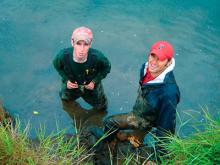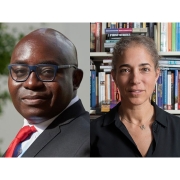Just the Facts

Penn Arts
and Sciences Magazine: Spring/Summer 2012 issue
by Peter
Nichols
photo courtesy of Ben Horton
"Ben Horton is a climate liar," an Internet headline screamed just days after his groundbreaking study was published in the Proceedings of the National Academy of Sciences. Horton's 2,000-year overview of the link between the fall and rise of global temperature and the ebb and flow of sea level also found an unprecedented rise of ocean waters starting at the dawn of industrialization.
Benjamin Horton is an associate professor in the Department of Earth and Environmental Science and director of the Sea Level Research Laboratory. A coastal geologist, he studies how coastlines change under the effects of shifting landmasses and a restless sea. "Sea level rise is a potentially disastrous outcome of climate change as rising temperatures melt land-based ice and warm ocean waters," he explains.
Because his research touches on the fraught subject of global warming, bloggers and talking heads like to take shots at him. "Oh, I've had emails from people calling me all names under the sun," he notes. Some responses are smart and substantive, offering plausible challenges to the science, but many attacks hurl criticism with blustering, talk-show disdain for the formidable data that he and other scientists have piled up.
"What do they think I do when I come to work?" he wonders. "Do they think I recruit graduate students and then tell them to lie—that we're going to make up some numbers that show the sea level is rising? The science isn't perfect, but take any variable that has to do with climate change—temperature, ice cover, glacier volume, sea level—and it's hard to make a case that it's not happening."
The 2009 United Nations Climate Change Conference in Copenhagen was "an earth science disaster," he laments. Despite a near unanimous consensus in the scientific community that human-induced climate change is underway, world leaders couldn't agree on a treaty that set limits on greenhouse gases. Still, that doesn't mean opinion on global warming should be "a matter of belief," he comments, or an ideological marker on the fractious landscape of America's political discourse.
"Why can't we be honest and say that the fiscal implications of mitigation are too severe in this economic climate to do anything about it? I'd be fine with that. But to insist that it's not occurring just makes you look stupid because the data is so very clear."
From his chair, Horton gestures toward a wall-size map of the world in his Hayden Hall office, sweeping a hand across coastal regions where he has carried out fieldwork on earthquakes, tsunamis and sea levels in lands that touch the Atlantic, the Pacific and the Indian oceans. The map's fixed boundaries, where green continents touch bright blue oceans, give an illusion of terra firma. But earth scientists like Horton know that air and land and water comprise an interlocking system of never-ending, planet-wide flux. If you want to see it, you have to observe over long timescales—or else devise a finely calibrated instrument that can measure minute changes.
"If we refuse to mitigate climate change," he maintains, "then we're going to have to adapt, which means we'll need to understand how coastlines respond to sea level. To do that, you have to go back in time and find out."
Although he didn't invent a time machine, Horton did pioneer a method for determining past sea levels, with a high degree of precision, by looking at microscopic life forms called foraminifera. On coastal salt marshes, different species of the microorganism inhabit very specific ecological niches, tightly defined by levels of salinity, which is related to how much water flows in. He applied the technique to work out the first-ever continuous 2,000-year reconstruction of sea levels. The grants supporting the project, he stresses, were written not to confirm a hypothesis about global warming but to test whether his unusual approach would hold up when used to track sea level fluctuations far into the past.
"Salt marshes live just above sea level," he explains, "but they need to be inundated twice a day by the tide. If sea level falls, they move seaward; if sea level rises, they move landward. They're in equilibrium."
That delicate balance is recorded in layers of sediment that contain the signal species of foraminifera. By identifying and surveying which species of microfossils had accumulated, investigators can calculate where sea level had been.
To do that, Horton and his team of graduate students examined the foraminifera left behind by nearly 1.5 million high tides that flowed into and out of salt marshes on the Outer Banks of North Carolina. They drilled into the mud, pulled out eight-foot cores of sediment, wrapped them in plastic and drove them back to walk-in freezers at the Sea Level Research Laboratory.
On Penn's campus, postdoc Andrew Kemp, Gr'09, set about the tedious job of cataloguing and counting the species of foraminifera in the cores, one centimeter at a time. He also needed to determine the timeline for when the minuscule creatures lived in the layers of mud he was analyzing. For that, microscopic fragments of coastal grasses picked out of the core slices were radiocarbon dated to establish when the cross section was laid down by the sea.
But carbon dating won't work for the near past. For the last 250 years, the scientists improvised, using the history of colonial and modern America to provide clues for time horizons in the sediment cores. Colonists kept diary accounts of plants they brought from Europe for farming, and pollen that drifted into marshlands from vegetation they introduced told the sea level researchers what year of sediment they were looking at. Traces of lead spewed into skies by the invention of automobiles (or its decline due to the removal of lead from gasoline) as well as the appearance and disappearance of cesium-137 from atmospheric testing of nuclear weapons helped establish dates of other core strata.
The investigators analyzed two cores from sites 75 miles apart. The 2,000-year stories they told about sea level change were identical, and 70 years of sea level data recorded by nearby tide gauges further confirmed that the reconstruction was reliable.
Horton then worked with an international group of climate scientists to see how ocean levels in his model lined up with two millennia of global temperatures, which have been well established in studies of tree rings, ice cores, coral and other proxies.
Looking back in time, the researchers found that temperatures and sea level had been relatively stable from 200 B.C. to A.D. 1000. Beginning in the 11th century, during a warm period called the Medieval Climate Anomaly, sea level rose annually by about half a millimeter for 400 years. That was followed by a second period of ocean stability associated with a cool period known as the Little Ice Age, which persisted until the late 19th century. At that point, as global warming got underway, sea level has risen by more than two millimeters each year.
"So we've got this relationship for 2,000 years showing that temperature is driving sea level," Horton observes. "The rate of change we see in the 20th century is far greater than anything we've seen for 2,000 years. It's another piece of very, very strong evidence to show that the climate in which we have been living in the 20th century is so very different from what we had been living in prior to the industrial revolution."
Horton cautions that scientists talk about relative sea level, which means there is no absolute ocean surface: sea level is always related to where and when a measurement is taken. In the same time period, it can be different along different coasts or even along the same coastline. "Trying to understand this very, very abrupt rise in sea level and how different the record in the Carolinas might be from other sites on the Atlantic coast or anywhere else in the world is what's driving our research at the moment," he says.
A $1.5 million grant from the National Oceanic and Atmospheric Administration is funding Horton's study of the whole Atlantic coast and the development of models to predict sea level rise as well as the flooding effects of hurricanes. Core sampling from Maine to Florida reveals that sea levels had varied along the coast in some time periods of his reconstruction, but in the 20th century, all the measurements show a sudden and steep rise in ocean waters.
In the spring, he'll meet with coastal managers, business people and shore residents to help seaside communities plan and prepare for swelling ocean waters. "We're just going to describe our project," he says. "We're not going to debate climate change."
In the summer of 2009, near a field site in Georgia, Horton and his grad students rented a house on an estuary in Savannah. They were there on an Earthwatch expedition with 10 high school kids who wanted to learn something about what real scientists do.
The landlady told the group, "I don't believe in climate change."
"She was a lovely woman," Horton observes, "and she had made that decision like it was something to do with faith. I tried to convince her about the data behind climate change," he says. "I always try to show that scientific investigation is about the search for truth, but she was having none of it."
Meanwhile, each day Horton and his crew of young scientists put on their boots and sun block and mosquito-net hats and walked out the door into a heat wave, painstakingly compiling the data connecting climate change to Georgia's ever-shifting coastline, in the hopes that the evidence will speak for itself.
"I'm not telling anyone what they should do," says Horton. "I'm just saying, 'Look, guys. Sea level's rising.' That's the data."





